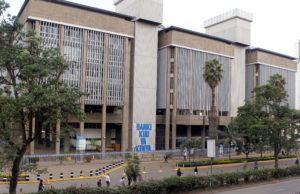The Central Bank of Kenya

A general view shows the Central Bank of Kenya headquarters building along Haile Selassie Avenue in Nairobi, Kenya November 28, 2018. REUTERS/Njeri Mwangi
The East African Currency Board
On 10th June 1965, Kenya’s first Minister of Finance, James Gichuru, announced during a budget speech that the government intended to establish its own central bank and issue its own currency. Until this point, the East African Currency Board (EACB) undertook the role of the central bank. Tanzania and Uganda, where the EACB also operated, echoed these sentiments as well. EACB continued its operations until preparations were finalized, just as it had done since its establishment in 1919.
The Indian Rupee Crisis
When the East African Currency Board came into existence, the main aim was to control the currency of the soon to be Kenya colony and the Uganda Protectorate. Joining the currency area in 1920 was Tanganyika. The EACB was meant to protect the imperial currency from misuse in the colonies just like the currency board set up by the British in West Africa. To do so, the currency board had to issue a token currency for use in the colonial territories that would be exchanged at a fixed rate against the sterling pound.
The silver rupee of British India was, at the time, the common currency in East Africa. This presented a challenge for the EACB from the onset. The value was at fifteen rupees to the pound or 1 shilling 4 pence (1sh 4d) before and during the First World War. Things changed at the end of the war in 1918 when the enhanced price of silver resulted in a revaluation of the rupee to 2sh 4d. This disrupted trade between India and the rest of the British empire, particularly East Africa. The most vexed group in the region was white settlers. This was the population that made transactions in rupees but stored their capital in pounds. They began to demand the restoration of the rupee’s prewar value.
On the flip side, the Indian community of East Africa insisted that the rupee be maintained at the new market value. This group stored its capital in rupees, making the revaluation beneficial to their commercial interests. The Indian community was much larger than the white settler community and made up a bigger client base for banks. As a result, the National Bank of India, the Standard Bank of South Africa and the National Bank of South Africa refused to endorse the stabilisation measures because it would hurt the Indian traders and their own profits. A stalemate ensued in which the banks and the colonial settlers refused any deal brought before them that did not serve their interests.
Introduction of new currencies
After numerous negotiations, the parties finally reached a compromise in 1920. The rupee stabilized at 2 shillings or 10 rupees to the pound and in came the new currency-the Florin.
Almost as soon as the florin came into use, unprecedented market forces caused the Indian rupee to plunge in value to 1sh 6d. Since the EACB had pledged to redeem rupees in East Africa at 2 shillings, the florin became overvalued against the market price of the Indian rupee. The Indian rupee smuggling into East Africa began. This trafficking reached such high proportions that the EACB found itself facing bankruptcy. To counter this, the EACB forced the cessation of the Indian rupee as legal tender in East Africa in 1921. The residents asked to redeem their coins at the rate of one florin for each silver rupee. The East African shilling replaced the florin in 1922. The exchange rate was at 20 shillings to 1 pound.
Solving the rupee crisis paved the way for other nations to come under the EACB. Zanzibar joined in 1936. In 1942, the board introduced the East African shilling as legal tender in British occupied Italian Somaliland, Eritrea and Ethiopia. The British protectorate of Somaliland followed suit in 1943. These countries withdrew from the currency board either after gaining independence or after creating their own currencies. This left the initial three territories.
Creation of the Central Bank of Kenya
After independence, EACB started performing some central banking functions in the absence of one. They provided credit to the government and lent to commercial banks for crop financing. However, the board’s functions could not match those of a central bank.
The Central Bank of Kenya was finally established on 24th March 1966 and opened its doors to the public on 14th September 1966. CBK is mandated to formulate and implement monetary policy that promotes price stability. It also fosters liquidity, solvency and stability of the banking sector, issues currency notes and coins. Furthermore, it provides banking services to the government, commercial banks and other financial institutions.




2 Comments
As always, thanks for the fascinating history lessons!
If you haven’t done so already, please visit the Central Bank permanent exhibition at Nairobi National Museum, for a visual interpretation of your write up.
Asante sana! We have visited said exhibition and it proved to be very valuable to our writing process.